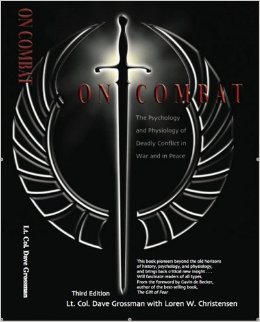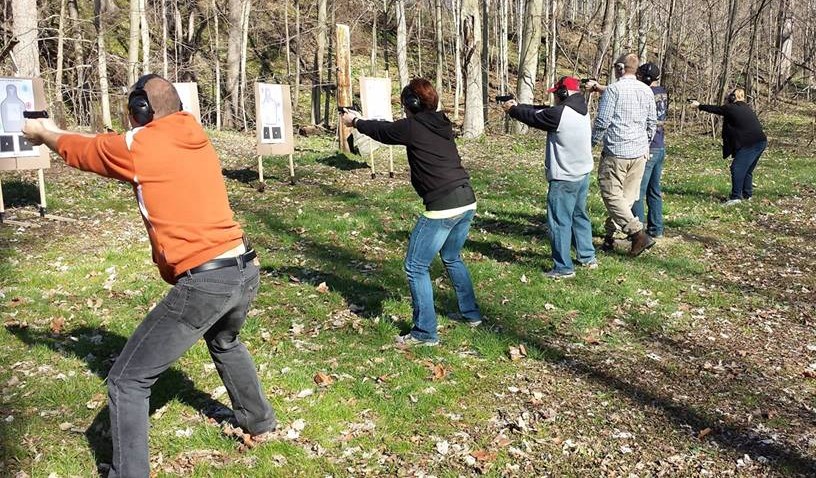
Being prepared to carry a defensive firearm is not as simple as just going out and buying a gun. Much more is involved in being mentally and physically prepared to use a firearm. Photo: author
Much more training and study are required to get to the level you should attain prior to carrying a defensive firearm. You don’t need to be an expert shooter. In this article I explain what I believe your minimum level should be prior to carrying a defensive firearm.
I teach a lot of newer students who are taking a defensive handgun training class to obtain their concealed handgun license. Many of them are able to meet the requirement but in my opinion are not ready to carry. I am open about this with students and in certain situations have even told students, “Don’t carry a gun.” Here are a few things I think are important to prepare you beyond an arbitrary state minimum requirement.
Mentality
Prior to carrying a defensive firearm, take a step back and check your reasons for carrying. If these reasons include to stop a robbery, protect your money, your car stereo, or any other personal property, you should not carry a defensive firearm. Trying to stop crime as a civilian is absurd. Your defensive firearm’s only mission is to protect you or others from a threat of serious bodily injury or death, not from financial loss. The financial, psychological, and social losses of using deadly force far outweigh any benefit, and killing someone over property is not acceptable in modern society.
Law enforcement officers do not get this luxury and are sent into the bad places to capture the bad people, but there are important notes for mentality in law enforcement as well. Many times law enforcement has trouble backing away from a situation to get help. The complacency of the “routine” domestic call or “routine” traffic stop, where the person is being verbally or physically non-compliant, can be a killer. Understanding that just because 100 people in the past eventually complied does not mean that the 101st is going to can save your life.
Recently in my area, an LEO entered a room with a subject who had mental health issues and was believed to possibly have a handgun. The LEO left himself very exposed, and the subject used a pistol-shaped object under his shirt to convince the LEO he had a handgun. The incident ended with the LEO shooting and killing the suspect. I believe this LEO’s intentions were good and he didn’t think for a moment he would need to shoot the suspect. I am sure in his fairly lengthy law enforcement career he had been involved in many similar calls that ended peacefully.
The fact that the LEO entered the room did not make it “wrong” that he shot the suspect, but this is a case where a life may have been saved had the LEO reconsidered entering the room. This is a perfect example of when using discretion and accepting that you cannot solve by yourself all the issues you will face is important knowledge to have.

Reading On Combat is a great way to learn about the psychological and physiological effects of combat.
I suggest reading Lt. Col. Dave Grossman’s book On Combat to learn more about the psychology of killing in combat. It explains how you are affected mentally and physically in a fight and how you should prepare. Lt. Col. Grossman is also a PDN contributor and covers these topics in numerous videos here on the PDN site.
Safety
Many people carry prior to being ready from a safety perspective. People often tell me they carry without a round in the chamber for safety reasons. I am always quick to tell those individuals that they are not ready to carry a handgun if they are not comfortable with the idea of a loaded chamber. Modern defensive pistols are made to only fire if the trigger is pressed. Specifically, striker-fired semi-automatics have nearly a 0% chance of going off unless the trigger is pressed. Many times I have seen someone fumble a draw and throw their gun, and never once has there been an issue with the gun going off.
Why then do people feel the need to carry without a round chambered? I believe they are compensating for their lack of training and understanding, as well as attempting to cover themselves for their lack of trigger-finger discipline. Training yourself not to touch the trigger unless you are prepared for a bullet to leave the muzzle is the best way to prevent a negligent discharge. Your trigger finger should be high and away from the trigger and not visible from the other side of the handgun.
In every defensive handgun training class I teach, I have students with trigger-finger issues. I suggest to many of them that they practice where to place their finger – but not with their defensive firearm. Instead, get a toy gun or an airsoft gun. Hold it while you are watching TV or other such activities and make sure you maintain proper trigger-finger discipline. If you continue to have trouble, tape your finger in the proper position with first-aid tape. Continue doing this until it becomes natural to hold the pistol in this manner.
Law enforcement is by no means exempt from this rule. I have heard of departments that will not move to striker-fired guns due to worries of officers having negligent discharges. If an officer has issues with trigger-finger discipline, they are no more ready to carry a gun than the average citizen with the same issue. One department I know of with this issue carries a traditional double-action pistol that has a heavier first trigger press for this reason and will not make the switch. I have read research that shows the clenching of the hands when holding an object that is caused when the person is startled has been measured at up to 25 pounds. This far exceeds what is necessary to fire a double-action trigger. The answer is not a piece of equipment but more training for the officers who have the issue.
Get Medical Training
I carry a firearm the vast majority of the time, but also a small trauma kit, including a tourniquet. I cannot stress enough how important medical training is. Even though I am a firearms instructor teaching defensive handgun training, I firmly believe medical training is more important. I routinely tell classes this and they look shocked. I remind them that although I have never had to shoot someone, I have had to render first aid many times. I hope it stays that way.
You are much more likely to need to bandage a wound, stop bleeding, or provide CPR than you are to shoot someone. If you are in the unlikely situation of shooting someone, your chances of needing this medical knowledge are extremely high as well.
If you are carrying a defensive firearm to protect life, you should also know how to protect life through basic medical training.
For any medical gear you carry, open the package and learn where each item is located. Having the right equipment (bandages, hemostatic agent, et al) but not knowing where they are or how to use them means you waste valuable time.

These students were in class to improve their skill levels. This was not a course to meet a state requirement. Students attended because they take their defensive handgun training seriously.
Photo: author
Defensive Handgun Training
Taking a single intro-level class or even a law enforcement qualification course by no means completely prepares you for carrying a defensive firearm. In fact I believe you can never be prepared enough. You should continue to train not only to increase your skill levels but to maintain them. Defensive shooting skills are perishable and you do not want to find out how many of those skills you have lost when you need them to save your life.
I can personally attest to some loss of skills myself. A few years ago, I had more time for defensive handgun training and practice on a regular basis. But now being busy teaching and working full-time makes it hard to find time to practice. I have fit training into my schedule and can see a depreciation in my skill level. I am now making even more of an effort to seek out training myself to improve my skill level and knowledge. Even after taking a single class recently, I saw dramatic improvement.
This does not necessarily mean you have to pay hundreds of dollars to train every month, but you should be out practicing defensive drills that you have learned in class to maintain and improve your proficiency. Taking a new class every month or even every three months may not give you the time required to become proficient in those skills. Learn the skills and practice them, then seek further knowledge rather than just bombarding your brain with a lot of different knowledge and not being able to ingrain it.


Just another watered down if you are not trained to my standards you shouldn't carry. Thank You Sarah Brady
I can fully appreciate your column. After returning from South East Asia during the Vietnam War I spent a great many years in therapy due to taking peoples lives.T tge time in combat I didn't stop to think how it would effect me. Once home I not only thought about it but the lives that could have come from King a life from future families. And yes there were some young lives that were taken. Many other countries use kids to fight there wars. So I even think about the possibilities today of having to possibility take a young life when carrying to protect myself and loved ones. However not carrying is not even an issue due to the possibility of losing a loved one. Yes, there is much to consider when picking up a firearm. Dave B.
I had commented on this over five years ago (it's listed below). The only addendum that I want post after all this time is that it is obvious to me that nowadays many criminals simply want to get their "bones" so as to get "creds" for their inevitable return to prison. I've studied too many after-action reports where the perp, after having received the victim's valuables, simply killed the victim for that very purpose. Bottom-line it: If a man pulls a gun on me; I'm going to try and kill him if I can.
Ready
What must I do
Jarrod, could I reprint your article and hand out to my LTC students? It is fantastic. If not, I understand. Glenn Cypress, TX
Outside the home, yes one in the chamber,BUUUT My home defense is a .45 ACP, I put the mag in and all it takes is the flick of my thumb to chamber a round. At 3am, getting woken from a sound sleep and being groggy reaching my night table , lights off is a recipe for an unwanted, and potentially fatal discharge. Any Comments?
Excellent article, an eye opener for the new shooter and for the shooter who doesn't practice nearly as much as he should.
Great article ! As a Christian, I would not think of shooting a human being to defend property, even if allowed by law. I also try to be aware of my surroundings, and avoid potential conflict. That said, if someone broke into my home, or tried to carjack my car, I would consider the danger they might present to me or others. I understand the theory that you keep shooting until the threat is stopped; but the thought of a miss or pass through hitting an innocent person seems far worse than my being shot, and most defensive shootings are at close range. My choice of a defensive firearm is a Ruger LCR, loaded with five 357 magnum cartridges. A 357/ JHP at close range would have the impact of being hit by an NFL lineman, plus the internal damage it would do.
You brought out very good points. Using a firearm in a liberal state can bankrupt you , even if you are justified. Know the laws in your area or you may end up behind bars.Learn to shoot accurately with your EDC. Practice frequently. Once you hone your skills there will be no need to fire large amounts of ammo. Most importantly is, if you can diffuse a situation by walking away do so. Walking away is better than months in court and years in jail. If you must defend yourself shoot to permanently eliminate the threat. You don’t want to get shot by a wounded criminal .